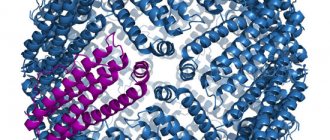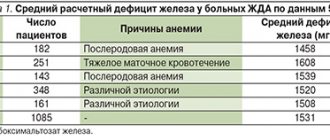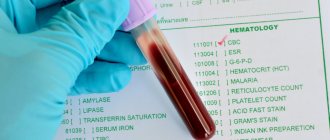Meanwhile, almost every seventh inhabitant of the Earth is a carrier of a “defective” gene that disrupts iron metabolism in the body, which ultimately leads to hemochromatosis (excessive levels of this trace element).
Fortunately, the “bad” gene is not triggered very often. But if it “works”, it won’t seem like much.
The floor goes to one of the leading experts in this field, gastroenterologist, candidate of medical sciences Svetlana Polyakova .
Causes of excess iron
An excess of iron in the body is often attributed to a pathology of heredity. However, the reasons for exceeding this substance may be associated with certain diseases.
There are two types of problem:
- Primary - hereditary. It is also divided into types, depending on the gene that carries the pathology.
- Secondary. Formed in connection with the development of diseases.
Hemochromatosis is a hereditary, genetic disease. Manifests itself as a result of impaired iron metabolism. An increasing volume of absorbed element leads to a deterioration in metabolism. The disease does not reveal itself in any way; it is hidden. Around the age of forty-five, a large amount of the element accumulates in the body. When the disease manifests itself, the consequences most often become irreversible:
- Chronic liver diseases, severe cirrhosis.
- Leukemia and nephritis.
- Impaired functioning of the pancreatic duct.
For a hereditary disease, there are good reasons for early examination:
- Premature death of relatives from sudden cardiac arrest, liver cirrhosis, and other diseases associated with iron intoxication.
- Hyperpigmentation in the armpits, on the palms (in areas where there is no sun tanning)
- Biochemical blood test detecting the presence of ferritin and transferrin proteins
The cause of the disease may be factors affecting the quality of life:
- Consuming large amounts of supplements and taking medications containing this microelement.
- Frequent blood transfusions.
- Using medications to treat anemia.
Risk factors include:
- Presence of the element in drinking water.
- Cooking food in metal dishes.
The appearance of iron in drinking water can lead to:
- Thickening of the blood and hardening of the walls of blood vessels.
- Formation of stones.
The causes of excess iron in women should be discussed separately. During reproductive age, she loses a lot of blood. This helps her not suffer from excess substance. But as soon as menopause occurs, the risk of accumulation of this trace element becomes the same as in men.
Taking hormonal medications and oral contraceptives is another reason for increasing the amount of microelement.
During pregnancy, iron is required for the structure of fetal organs. Its excess can be observed in the third trimester.
Hidden threat
Hemochromatosis is an insidious disease. For the time being, the disease shows almost nothing about itself. The bitter truth is revealed, as a rule, too late - by the age of 40, when the signs of hemochromatosis are obvious (from severe cirrhosis of the liver to diabetes and life-threatening arrhythmogenic cardiopathy), and it is almost impossible to do anything to save the patient. Unless a donor liver or heart is transplanted.
Article on the topic
Victims of iron deficiency risk anemia and anemia
Such consequences are caused by a congenital disorder of iron metabolism, as a result of which much more of this microelement is absorbed in the small intestine than the body requires. The result is sad: when deposited in the liver, pancreas, and heart muscle, excess iron causes lipid peroxidation, in response to which connective tissue begins to be actively produced in the affected organ, disrupting its structure, and therefore normal functioning.
Doctors can only shrug: if their predecessors had known about the presence of hemochromatosis in such a patient earlier, when he was a child or young adult, such problems could have been avoided.
Symptoms of excess iron in the body
An overdose of iron in the human body is expressed by symptoms that can easily be seen with the naked eye. The color of the skin changes, it becomes brown, weakness and apathy appear.
An increased content of the element in the body is accompanied by signs:
- The sclera, tongue, and palate acquire a yellow tint.
- Weight loss and heart failure occur.
- Iron provokes skin itching and a decrease in blood pressure.
- Changes occur in the liver, spleen, heart muscle, and kidneys. It is in these organs that the microelement accumulates the most.
- Libido decreases, and pain and swelling in the joints appear.
4.Can hemochromatosis be prevented?
Having hemochromatosis in one of your relatives does not mean that you will also have this disease. But if you have inherited the gene that causes this disease, you are more likely to have iron overload. It is important to monitor your health so that when the first signs of hemochromatosis appear, you can start treatment as early as possible. Timely treatment of hemochromatosis allows you to cope with most of the symptoms of the disease and prevent health problems in the future.
It is quite difficult to develop hemochromatosis from eating foods rich in iron. But it's always important to pay attention to how much iron you get from food and from vitamins or mineral supplements. Here are some simple steps you can take to make sure you don't take in too much iron from food and drink.
- Limit your alcohol intake. It helps iron be absorbed from food and increases the risk of liver damage (cirrhosis);
- Do not take large amounts of vitamin C in vitamin form (more than 200 mg per day). This can also increase the amount of iron your body absorbs from food. But you can eat and drink foods containing vitamin C without any worries;
- Do not take dietary supplements or vitamins that contain iron;
- If you need phlebotomy to treat hemochromatosis, talk to your doctor about changing your diet. You may be advised to eat less meat and iron-rich foods (cereals, for example);
- Drink tea and coffee. They will help the body absorb less iron. But tea and coffee are not a substitute for treating hemochromatosis as recommended by your doctor;
- Do not use iron utensils. Food cooked in it may absorb some iron;
- Don't eat raw seafood. They may contain bacteria that are harmful to people with hemochromatosis.
It is very important that all these recommendations are not absolute and necessary for everyone. According to statistics, lack of iron in the body and low hemoglobin are more common than hemochromatosis
. Therefore, there is no need to try with all your might to reduce iron intake unless there are the necessary prerequisites or doctor’s recommendations for this.
What is the danger of exceeding the norm?
The consequences of excess iron are very serious. An excess amount negatively affects the work:
- The liver is the filter of the whole body. If you notice the signs in a timely manner and begin treatment, the functioning of the vital organ will normalize. Otherwise, liver cells may be destroyed. This will lead to diseases: hepatitis and cirrhosis, necrosis, inflammation of the gallbladder.
- Kidneys. Excess trace elements are collected in the nephrons. They constantly poison the body. The filtration ability decreases, which provokes the occurrence of diabetes mellitus. Protective functions deteriorate, inflammatory processes develop.
- Impact on the nervous system. The brain suffers, the hypothalamus is overloaded. The head begins to hurt, thinking gradually slows down.
- Muscles. Excess iron causes fibers to break. Pain appears and muscle tone is lost. The heart is also a muscle. Poisoning it with iron can provoke the development of a micro-stroke or micro-infarction.
- Spleen. The main function of the organ is part of the metabolic processes occurring in the body, as well as the synthesis of iron. Gradually, iron is deposited on the walls of the organ, and inflammatory processes develop. They can penetrate nearby tissues.
Changes in nutrient balance during pregnancy are dangerous. Not only the expectant mother suffers, but also the child. From the mother's blood he receives all the substances he needs. Iron is an important component of hemoglobin. But in pregnant women, excess iron can provoke pathology of the placenta, to a greater extent the oxidation of free radicals, mitochondria in the placental cells die. Excess can cause gestational diabetes, which leads to miscarriage and subsequent development of infertility.
To prevent this from happening, blood tests are constantly taken from the expectant mother. Women should take medications containing Fe with caution and monitor the dosage.
It is more difficult to treat the consequences resulting from excess iron than from deficiency. Especially if the accumulation in the body has occurred for a long time, or it is a hereditary disease. But if the patient consults a specialist in time, when it is possible to avoid the bitter diagnosis of damage to internal organs, then the prognosis may turn out to be quite favorable.
Treatment
Hemochromacy does not occur on its own, but is provoked by certain risks that the patient should be aware of, be it heredity or frequent blood transfusions. If you notice the first symptoms, you should consult an endocrinologist, since delaying treatment leads to a worsening of the body’s condition.
During the treatment process, the endocrinologist prescribes a special diet to the patient, which excludes foods rich in iron from the diet, including apples, beets, buckwheat, red meat, red grapes, and pomegranates. Any alcoholic drinks are excluded; moreover, alcoholism itself causes hemochromatia.
Excess blood is treated through drug therapy prescribed by a doctor. Another effective way to combat this disease is periodic bloodletting, which also must be carried out under the close supervision of a doctor, as the level of hematocrit and hemoglobin in the blood should be monitored.
Symptoms of hemochromatosis:
- The most recognizable symptom of hemochromatosis is a specific gray-brown or bronze skin tone (the disease is also called “bronze diabetes”). The patient’s face, neck, arms and legs, and genitals are “painted” in such shades. At the same time, the folds of the skin and palms remain light.
- weakness, apathy, fatigue, decreased libido
- weight loss
- hair loss on the face and body
- pain in the joints and right hypochondrium.
Causes of hemochromatosis
Normally, our body should have from 300 to 1500 mg of iron. Moreover, every day there is a cycle: a person receives 10-20 mg of this microelement with food, but about 1 mg is absorbed - and the body loses the same amount of iron. And in patients with hemochromatosis, up to 3-4 mg of iron per day is absorbed in the gastrointestinal tract and up to 1000 mg of “excess” iron accumulates over the course of a year. The causes of hemochromatosis are mutations of a gene located on the 6th chromosome. The anomaly is inherited and affects three people out of a thousand. Mostly these “lucky ones” are men: they suffer from hemochromatosis 10 times more often than women. The disease, as a rule, does not bother both of them until they are 40-60 years old. Although sometimes the disease overcomes even at the age of 18-30 - this is juvenile hemochromatosis.
In addition to the primary
(idiopathic) hemochromatosis, inherited, is also
secondary
or acquired. Hemochromatosis can be “acquired” by people suffering from liver disease, chronic alcoholism and certain blood diseases, as well as those who have abused iron supplements and have undergone repeated blood transfusions.
Reduced iron content.
At the moment, there are many factors that can cause low iron levels in the blood. The most likely causes of low iron content are insufficient intake from food, impaired absorption in the stomach and metabolic disorders. There are situations with absolute or relative iron deficiency. Such cases include lactation, pregnancy, periods of development and growth. Another cause of iron deficiency can be chronic or acute blood loss.
Insufficient iron content manifests itself as:
- slowdown in physical and mental development;
- iron deficiency anemia;
- inappropriate behavior in children;
- weakness, fatigue, dizziness and headaches;
- decreased concentration and memory;
- brittle nails;
- perversions of taste;
- immunosuppression and, as a consequence, frequent morbidity.
Calcium promotes the absorption of iron, while vitamin E and zinc, on the contrary, reduce the body’s ability to absorb iron.
Our clinics in St. Petersburg
Structural subdivision of Polikarpov Alley Polikarpov 6k2 Primorsky district
- Pionerskaya
- Specific
- Commandant's
Structural subdivision of Zhukov Marshal Zhukov Ave. 28k2 Kirovsky district
- Avtovo
- Avenue of Veterans
- Leninsky Prospekt
Structural subdivision Devyatkino Okhtinskaya alley 18 Vsevolozhsk district
- Devyatkino
- Civil Prospect
- Academic
For detailed information and to make an appointment, you can call +7 (812) 640-55-25
Make an appointment
Iron plays a very important role in the human body. It performs the function of oxygen transfer, takes part in oxidative processes, enzymatic reactions, providing immune functions, and cholesterol metabolism. In addition to red blood cells, iron is also found in brain cells.
Diagnostics: what tests need to be done
Dangerous complications such as liver cirrhosis and diabetes are common, but not obligatory, consequences of hemochromatosis. You can avoid them by detecting the disease in time - a gastroenterologist will help with this. The doctor will order a blood test (biochemical, general and blood sugar test) to find out how much the normal iron levels are exceeded. And other studies - ultrasound of the abdominal organs, magnetic resonance imaging, electrocardiography, liver biopsy and x-ray of joints - will determine which organs and how much are affected by the disease.
It is advisable for the patient’s close relatives to undergo the examination as well – they are also at risk for hemochromatosis.








